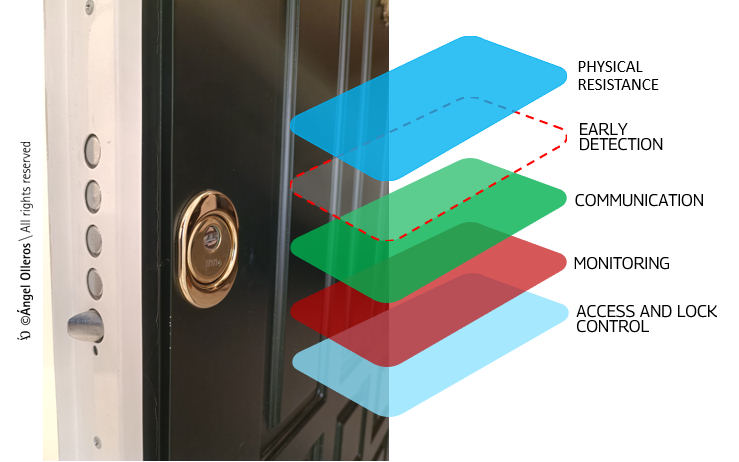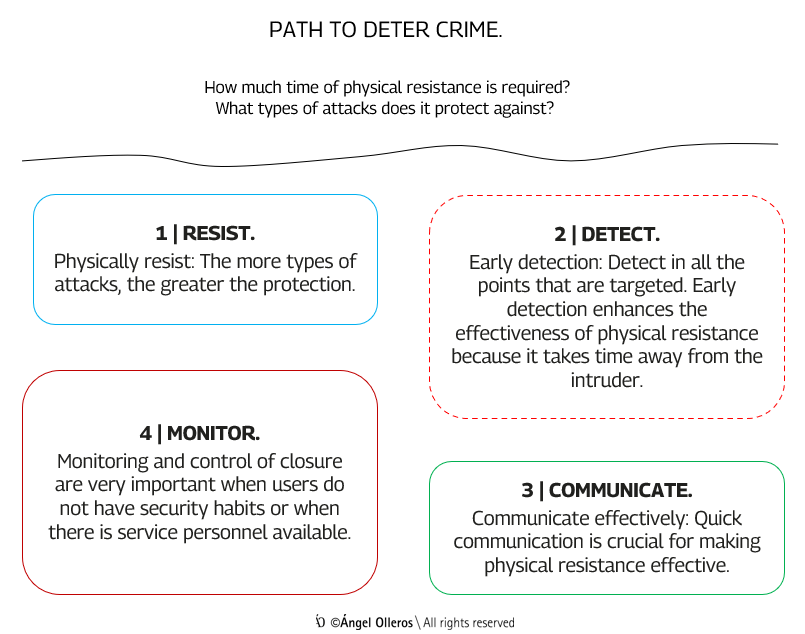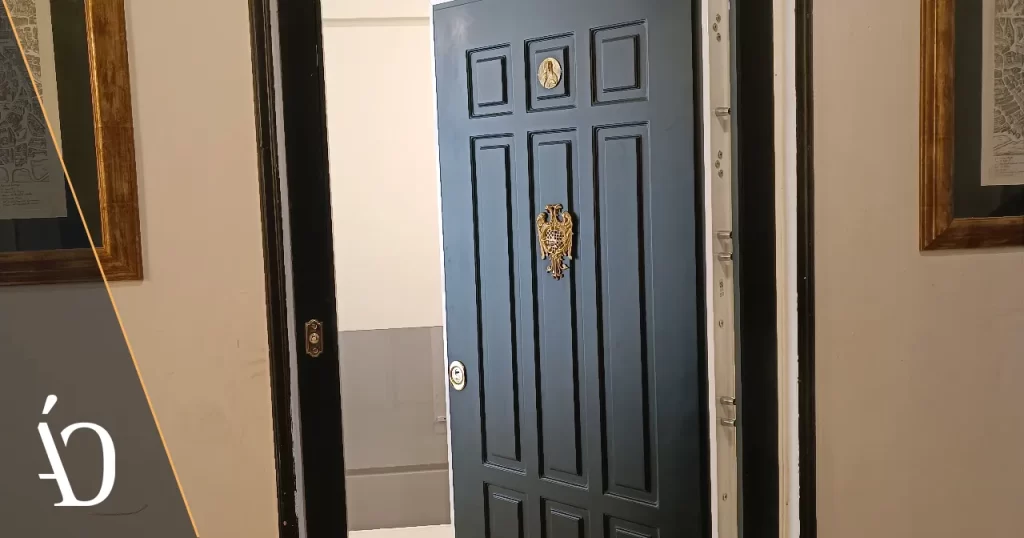Tiempo de lectura: 11 minutos (0)
Our English podcast will surprise you. It’s clear, engaging, and provides insights into security doors that prevent intrusion by making even the most technical concepts accessible.
Podcast summary on security doors that deter crime:
Door, alarm, camera, and secure locking all in one. These are technically smart security doors that offer no opportunity for intruders, even if homeowners forget to lock up or activate the alarm detection system.
Some consumers face serious financial constraints that prevent them from achieving optimal protection. However, many others, without such limitations, live at high risk simply due to poor advice.
Welcome to this article, which explains the essential features security doors need to counteract the strength, expertise, and resources of professional intruders.
What are crime-deterrent security doors like?
They are always locked, withstand various physical attacks, detect threats in advance, communicate the attempted breach, and alert the intruder.
Today’s intruders are no longer deterred by alarm signs, self-installed commercial solutions from the internet, or even armored doors. Wireless alarm systems advertised on TV are also ineffective, as their vulnerabilities are widely known.
To repel intruders, it’s crucial to demonstrate the challenges they’ll face when attempting to breach the home. This can be achieved by: (A) countering each type of attack with a specific feature designed to neutralize it, and (B) actively alerting the intruder through a speaker system that notifies them they’ve been detected.
The effective layers to repel an intrusion attempt are: (1) physical resistance, (2) early detection of an attempted breach, (3) communication of the breach attempt, (4) monitoring of the door’s status, and (5) access and locking control.
It’s now possible to purchase security doors that prevent intrusion that incorporate these layered protections to increase the difficulty of intrusion.

Is it possible to prevent an intrusion with a reinforced or armored door?
Typically, the answer is NO.
Reinforced doors and armored doors are commercial terms often used to describe the quality of a ‘secure’ door, but they don’t actually provide the necessary information for making an informed decision. These terms have become devalued because sellers frequently use them with little technical accuracy, solely to promote their product over competitors.
___
Police notification: They don’t arrive in time to prevent the intrusion.
Example of resistance time, detection, and police intervention. ‘The numbers don’t lie.’
Considering a professional intruder: a reinforced door offers physical resistance of 1 to 3 minutes, while an armored door provides resistance of 3 to 5 minutes. The time needed for a typical apartment robbery is under 15 minutes. The notification protocol for police dispatch usually exceeds 5 minutes (alarm companies often misrepresent this). The average police response time ranges from 20 to 40 minutes, depending on location, time of notification, and available patrol resources versus general crime reports within that timeframe.
The recommendation is to request a detailed quote and a technical data sheet outlining the included features, the types of attacks these features defend against, and the resistance time (in minutes).
How many protections do I need to deter an intrusion?
It depends on the types of attacks you want to guard against and the duration of resistance needed.
Since we can’t predict the attacker’s profile, when they might strike, or the method of attack they’ll use, it’s necessary to combine various layers of protection to cover as many types of attacks as possible for the longest time, while communicating the breach.
How to reduce the door’s price by removing security features?
If covering all vulnerabilities isn’t a priority or the budget is very limited, you can start by omitting certain protections and accept the risk that the intruder might use precisely the attack method that was left uncovered.
We present the five security features that can be omitted to reduce the cost:
- The door only needs to resist minor attacks for 3 minutes.
- No need to detect an intruder tampering with the door.
- No need to communicate the attack.
- No need to monitor the door.
- No need to protect keys from unauthorized copying.
The layered protection in security doors that prevent intrusion includes physical resistance, early detection, and communication to effectively deter intruders.
Would you like to know the optimal questions for effective guidance?
In the link below, we list key questions for guidance on secure doors that deter crime.
What is the function of each layer in security doors?
TECHNOLOGY LAYER | FUNCTION |
Layer 1. Physical Resistance: | Withstands physical attacks using mechanical and/or electric tools. Resistance is measured in time for each type of tool. The most dangerous tools are mechanical, as they are highly effective, easy to use and conceal, and produce minimal noise Our recommendation is to purchase doors that comply with the UNE85160 standard. |
Layer 2. Early Detection: | Detects an attack in advance (while the door is still closed). Detection should occur in two different locations: along the full vertical length of the door frame (on the lock side) and on the protective shield of the cylinder. This setup enables detection of prying, forced entry, and drilling attempts at vulnerable points. |
Layer 3. Communication: | Communicates the attempted attack while the door is still closed. This can be an alert through a local siren, a notification to the client's mobile, or a verified, 24/7 communication sent to an alarm receiving center (ARC), which can then alert the police. Communication with Camera: The door includes a camera to verify that there is indeed a person attempting to force the door and not a false alarm. Communication with Camera and Speaker: The door includes a speaker that informs the intruder they have been detected and that the police are being notified. |
Layer 4. Monitoring | The door includes indicators that allow monitoring of its lock status. It differentiates between the door being closed with only the latch and being fully locked with all bolts engaged. This feature is highly useful for users. |
Layer 5. Access and Lock Control: | The door can feature a mechanical locking system operated with a security key or a multipoint electronic lock to automatically ensure the door is fully closed and locked with all bolts engaged. Security Key with Copy Notification: Electronic Lock: |
Recommended Brand: | We recommend the INN.SOLUTIONS brand. We have installed these doors in apartments, houses, and safe rooms with excellent results. |
What are the most important protections?
The most important protections are those that inconvenience intruders the most, forcing them to make noise, spend more time exposed in a hallway, carry heavy tools, and use more expensive equipment. However, all resistance has its limits, which is why early detection and communication of the attack are essential.
Ultimately, each person must decide their preferred level of protection and the amount of risk they’re willing to accept.

Notifying intruders is key to deterring crime.
It’s well known that alarm systems no longer deter intruders, as they are often disconnected, especially at night. Intruders know there is a high likelihood that the system is inactive.
To counteract user forgetfulness and ensure that intruders know the home’s system is always active, these crime-deterrent security doors feature a red LED on the armored shield and a small speaker that alerts the intruder they’ve been detected, that the police are being notified, and that they won’t have time to break through the door.
How many types of attacks exist to break a door?
Brands typically only advertise ‘anti’ features against bumping, picking, and extraction attacks, but they don’t specify the minutes of resistance these ‘anti’ features provide. In reality, there is a wide range of attack types on doors and alarm systems. Consequently, protection must be comprehensive, or it will be technically ineffective.
___
We list 16 techniques used to breach door security:
(1) Levering locks, (2) Levering hinges, (3) Structural removal of door framing, (4) Breaking the cylinder, (5) Breaking the protective shield, (6) Shearing shield fastenings, (7) Extraction of cylinder components, (8) Extraction of shield components, (9) Slipping the latch, (10) Bumping, (11) Advanced bumping, (12) Picking, (13) Electric tool picking, (14) Impressioning, (15) Technical key duplication, (16) Identity spoofing for key copying.
When the locking system is electronic, all vulnerabilities related to electronic insecurity and technical flaws in electronic products (especially wireless and battery-operated) are added.
How important is the installation of security doors that prevent intrusion?
Installation is crucial. According to ISO 22344-2 standards for residential buildings, door and window fixings must be attached to the building’s structure.
We recommend that the installer have a certificate from the manufacturer verifying that the technician (by name) has received the necessary training for optimal installation. Additionally, the technician or their company should issue a declaration of responsibility confirming that the installation was performed according to the manufacturer’s instructions.
How much does a security door that prevent intrusion, resists, and communicates an attack cost?
Prices vary depending on door dimensions and decorative panels. For estimation purposes, consider a standard-size security door for an apartment (82 x 203 cm) without decorative panels, offering optimal physical resistance at Grade 4C under UNE85160 standards. This door includes an early detection membrane in both the frame and armored shield, local communication, a camera, and speaker, priced at approximately €3,700 plus 21% VAT, totaling around €4,500 installed.
Adding an automated lock increases the price by €1,600 plus 21% VAT. If connection to an alarm receiving center (ARC) through a certified alarm system is desired, an additional €1,200 applies.
The total price for crime deterrence in a block apartment ranges from €6,000 to €7,500, depending on size and decorative panels.
Function | Price (excluding VAT) |
Physical Resistance: | 1.700 € |
Early Attack Detection: | 220 € |
Communication: | Local Alert: 80€ User Alert: 200€ Connection to ARC with 4G module and emergency battery: 500€ Add camera and speaker to alert the intruder: 230€ |
Monitorization: | Alert contacts for closed door and fully locked door with bolts: 100€ |
Access and Lock Control: | Motorized Electronic Lock: 1,600€ |
INSTALATION: | Door: 475 €. Complete Electronics: 590 €. |
Do not confuse a multipoint electronic lock with a battery-powered motorized cylinder.
The concept of automatic locking is becoming popular because it provides convenience for managing door access, especially in vacation rentals where owners are less concerned about security (the burglary risk falls on the tenants).
However, for our own homes, the situation is different. For true security, we recommend a multipoint lock with automatic and wired closure. If the priority is only ease of use, a battery-powered motorized cylinder may be sufficient.
Complete Guide to Security Doors
In the link below, you can find extensive information on the general details of security doors. This article, written in December 2021, remains fully relevant.
Frequently Asked Questions about Security Doors
Can a reinforced or armored door really prevent an intrusion?
Typically, no. The terms «reinforced» and «armored» have become devalued in the market and don’t guarantee real protection against professional intruders. A reinforced door offers resistance for 1 to 3 minutes, while an armored door withstands 3 to 5 minutes. Experienced intruders can bypass these defenses in much less time.
How many layers of protection do I need in a security door to deter an intrusion?
For effective protection, it’s recommended to combine various layers of security to cover the maximum number of attack types for the longest time possible. Essential layers include: physical resistance, early detection, attack communication, door status monitoring, and access and locking control.
Is it possible to lower the cost of a security door by sacrificing some security features?
Yes, but it’s essential to understand the risks associated with omitting each feature. To reduce costs, one might forgo functions like early intruder detection, attack communication, door status monitoring, or protection against unauthorized key duplication.
What are the functions of each layer of security in security doors that prevent intrusion?
- Physical Resistance: Withstands attacks using mechanical and electric tools. Measured in resistance time for each type of tool.
- Early Detection: Detects an attempted breach before the door is compromised.
- Communication: Issues a local audible alert, notifies the user’s mobile, or connects to an alarm center.
- Monitoring: Indicates whether the door is merely latched or fully locked.
- Access and Lock Control: Provides options such as secure keys with copy control or electronic locks.
What are the most important protections to consider in security doors that prevent intrusion?
The protections that most deter intruders are those that force them to make noise, remain exposed for longer, and use heavy, costly tools. However, early detection and communication of the attack are essential for complete protection.
Why is it important to inform intruders that the home is protected?
Many alarm systems do not deter intruders because they are often deactivated. Crime-deterrent security doors include a red LED and a speaker that alerts the intruder they’ve been detected and that the police will be notified.
What types of attacks can be used to breach a security door?
There are numerous techniques to compromise a security door, including levering, cylinder breaking, component extraction, bumping, picking, impressioning, and key duplication.
How much does a security door with detection, resistance, and attack communication cost?
A security door with optimal physical resistance, early detection, local communication, camera, and speaker costs around €4,500 installed. Adding features like an electronic lock or connection to an alarm center can increase the price to €7,500.
___
I hope this information helps you make better decisions.
Best regards,
JM Ángel Olleros
National Coordinator UNE CTN041/325: Crime Prevention through Environmental Design.
Spanish expert accredited by UNE at CEN (European Committee for Standardization) for the ISO/TC292/WG6 Security and Resilience working group.


 (3 votos, 4,67 de 5)
(3 votos, 4,67 de 5)